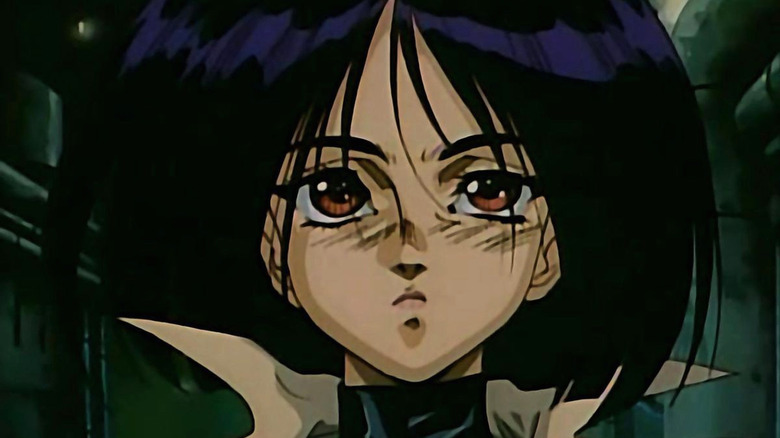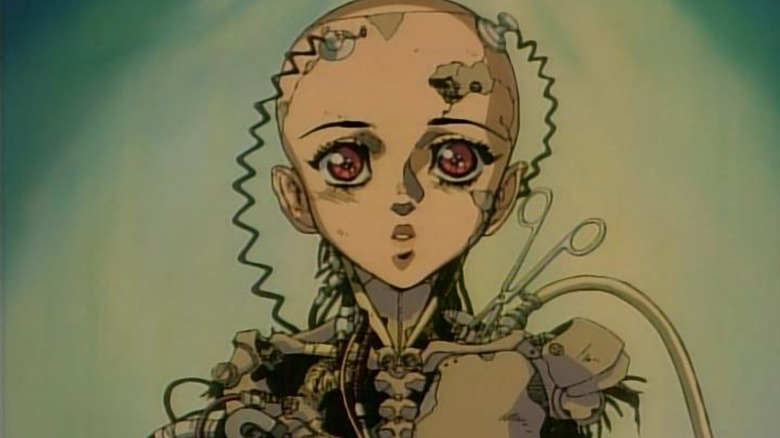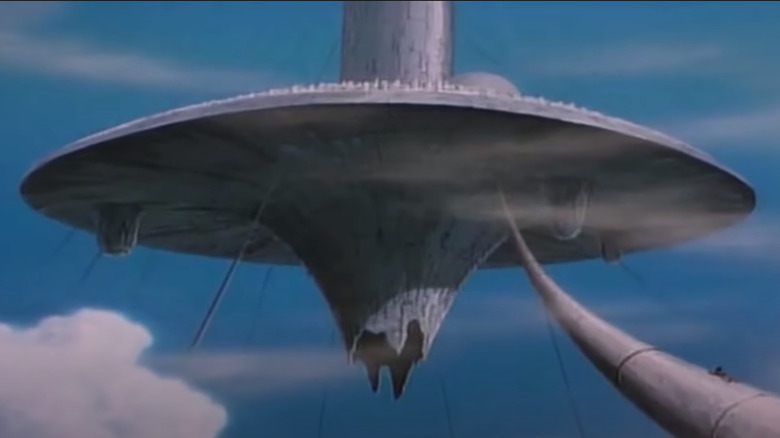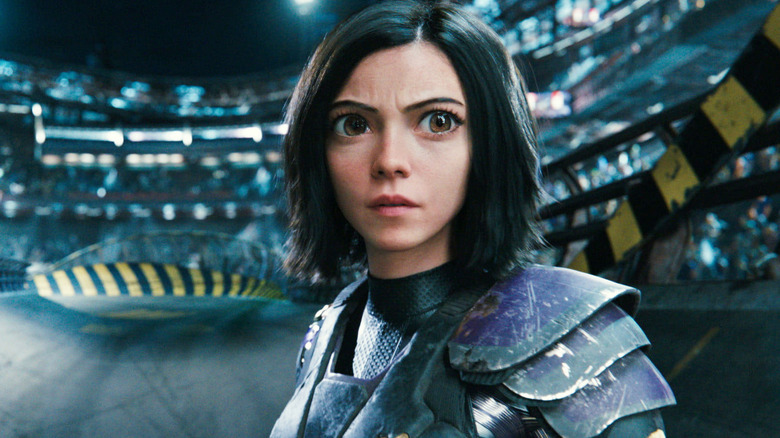If You Liked Alita: Battle Angel, It's Time To Check Out Battle Angel
The 1990s were a bountiful time for fans of cyberpunk, that beautiful science fiction subgenre that deals in transhumanism, the dangers of corporate rule, and exploring the capabilities of artificial intelligence. Films like "Johnny Mnemonic" would introduce the cyberpunk concepts of the 1980s to a wider audience through the magic of the movies, but there are many other, less well-known cyberpunk creations that deserve some love. While it's not technically a movie, the 1993 anime OVA "Gunnm," released in the west as "Battle Angel," is about an hour long and was released in the U.S. on a single VHS, so it sure felt like a movie. It's also an excellent adaptation of one of the best sci-fi manga series ever that inspired James Cameron and Robert Rodriguez to do everything they could to make a live-action adaptation a reality.
"Battle Angel" was based on the "Battle Angel Alita" manga series by Yukito Kishiro, and was comprised of two parts: "Rusty Angel" and "Tears Sign," each serving as a compressed version of one of the first two volumes of the manga. The OVA, directed by Hiroshi Fukutomi, is a shocking look at the future, when the rich can leave everything behind and the rest of us are left fighting for the scraps. There's a reason so many talented creatives have been drawn to this franchise, and the OVA is a great introduction.
Love and cyborgs
"Battle Angel" follows Alita, a centuries-old cyborg who has lost most of her memories. She is rescued and awoken from her several hundred-year slumber by Daisuke Ido, a cyberphysician who mostly makes his living fixing up people's broken cybernetics. The resurrected Alita goes by the name "Gally," and she has both rare technology inside of her and latent skills in combat that make her something of a super-being among her cyborg peers. Despite being centuries old and having a lifetime of experiences before her hibernation, Gally has the temperament of a teenage girl, which can be a bit frustrating when combined with her incredible speed and skill. She's an unstoppable force, but she's also impetuous and very human (at least her brain and spine are), and ends up falling in love with Yugo, a teenage boy who does maintenance work for Ido and has big dreams of moving up to the city in the sky, Zalem. He's so obsessed with Zalem that he doesn't even take Gally seriously when she shows him affection, so she tries to earn his love by saving up money to get them both to Zalem.
Gally gets that money by being a hunter-warrior (a bounty hunter), putting herself in incredible danger and bloodying her robot hands, but she's pretty darn good at it. (If the OVA had gotten a chance to go further and dig into the other manga volumes, we would have also gotten to see her become an alternative sports champion of sorts by competing in killer rollerball, but sadly, it was cut short at just two episodes.) Despite all of Gally's hard work to get herself and Yugo out of the sprawling dystopian city of Scrapyard and into Zalem, however, things aren't quite that simple.
The city in the sky
Gally and Yugo will never be allowed into the city in the sky for a variety of reasons, but chief among them is the classism of Zalem. The people who live in the sky believe that they are better than the people of Scrapyard, and the only way anyone's really allowed in from below is if they're the winner of one of the murdery roller derby competitions, earning a kind of celebrity status. It's very "Hunger Games" in that way, though the gladiators in roller combat are there by choice and not because they were selected in some kind of bogus lottery. The classism is all very similar though!
Fears of total separation between the have and have-nots has been a part of fiction going back to Victor Hugo's "The Hunchback of Notre Dame," which positioned that the streets of Paris were Hell itself, but "Battle Angel" takes the idea to another level. Zalem is the idea of heaven, and people in Scrapyard are willing to sacrifice anything in order to get there. It's a timeless fear, but one that becomes far more terrifying in a neo-capitalist cyberpunk future. As we've been heading towards a similarly oppressive world ourselves, the class allegory of "Battle Angel" feels more timely than ever.
A lasting impact
In 2019, "Desperado" filmmaker Robert Rodriguez gave us his version of "Gunnm" with "Alita: Battle Angel," starring Rosa Salazar in the eponymous role. It drew heavily from the first two manga volumes and contains a lot of the same story as the "Battle Angel" OVA, including Gally falling in love with a young man intent on getting into Zalem. It also managed to squeeze in some of the roller combat, which is great because it's a proper-sized arc in the manga and beloved by fans. "Alita: Battle Angel" has a deeply loyal fanbase, and even if you didn't like it, "Battle Angel" is worth checking out. It's a little more violent and sexual than its live-action counterpart (anime in the '90s was a helluva thing), so I don't recommend showing any younger fans unless you want to give them serious kindertrauma.
Zalem and "Battle Angel" also bear similarities to Neill Blomkamp's "Elysium," though that movie is significantly more self-serious and doesn't have nearly enough robot rollerblade battles. On the opposite end of the spectrum, Rodriguez's film is more of an action-adventure than the OVA, which is pretty dour in places because its story is ultimately a tragedy that sets Gally's overall adventure into motion.
It would be incredible to see another attempt at an anime series based on "Battle Angel Alita," and since it has fans as famous as James Cameron, Rodriguez, and Guillermo del Toro, it could possibly happen. "Gunnm" is the perfect story for animation, and it's as timely as ever, so maybe we'll get a chance to see Gally kick some cyborg butt again sometime soon. Until then, go back and check out "Battle Angel."



